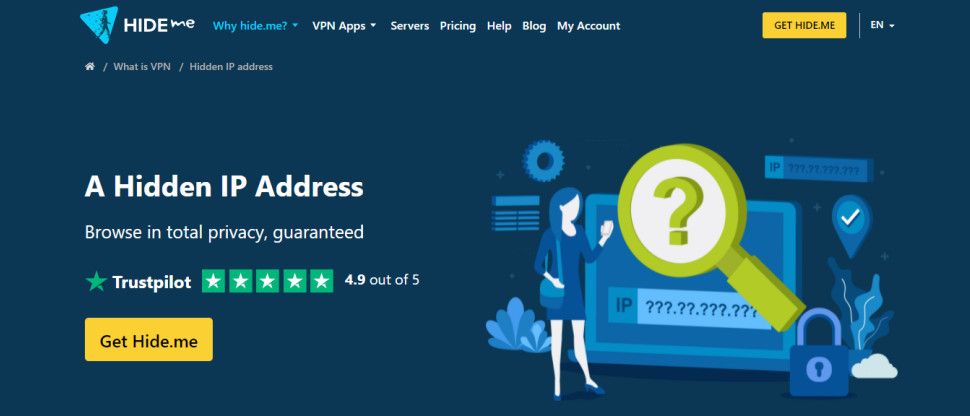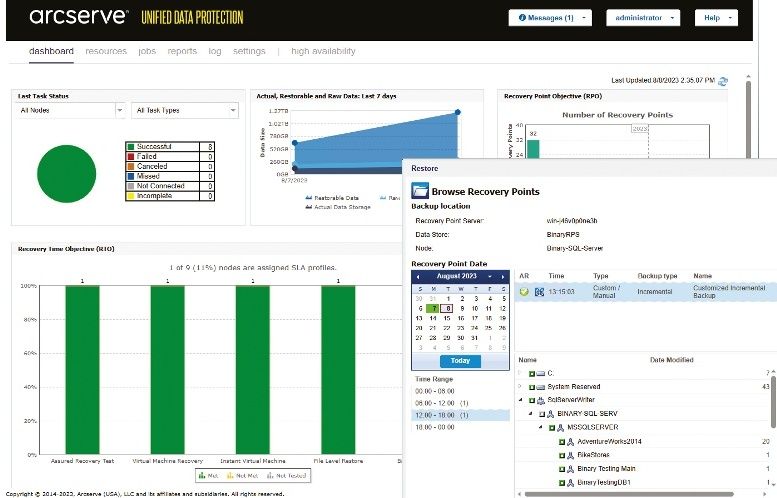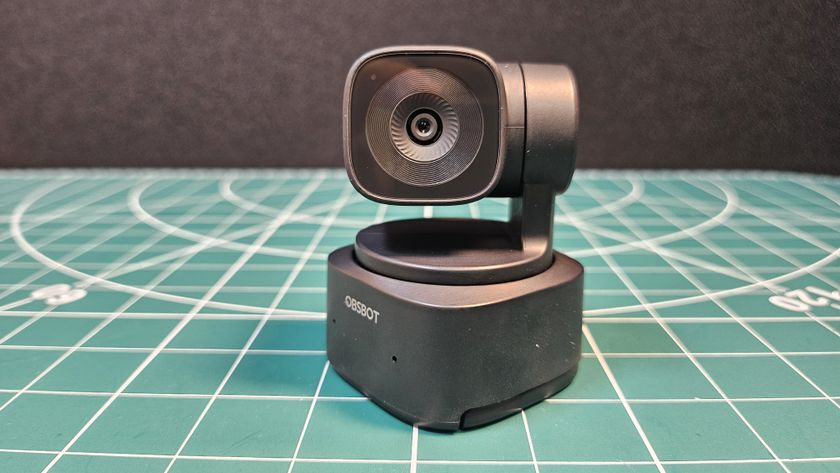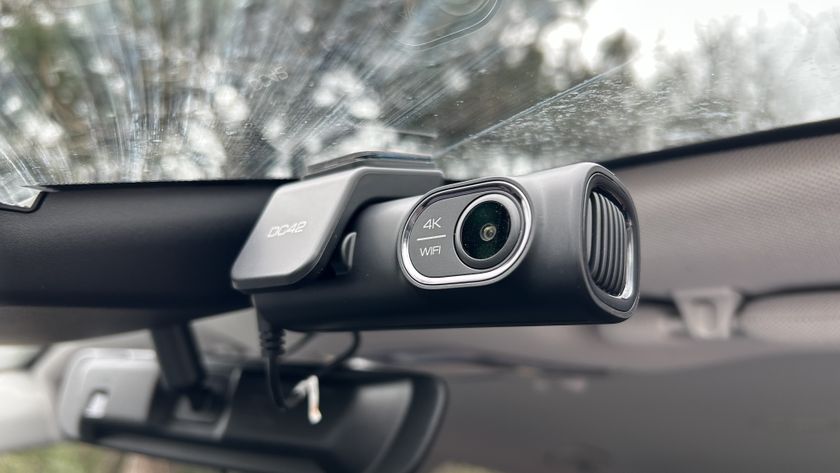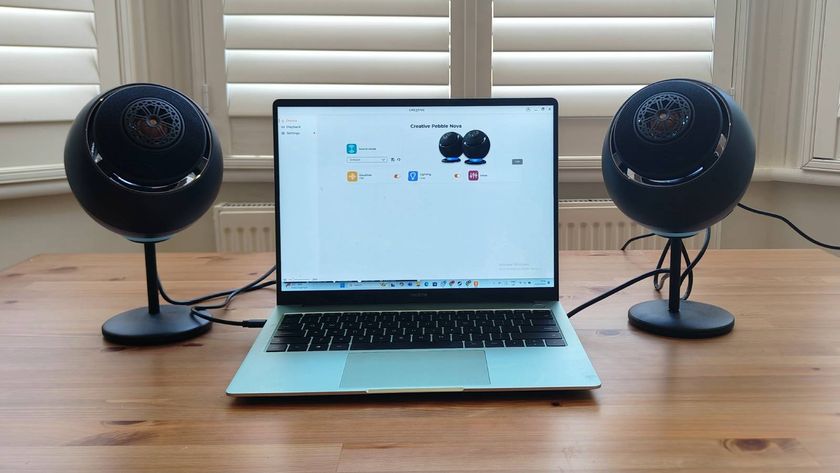TechRadar Verdict
This is a feature-packed VPN, and although the Windows app has some technical issues, it offers amazing speeds, great unblocking, and some of the best expert-level settings we've seen anywhere. A must-see for more demanding users.
Pros
- +
High-speed Windows and OpenVPN connections
- +
10Gbps servers highlighted in the app
- +
Unlimited data free plan
- +
Unblocked Amazon Prime, US Netflix, Disney Plus, iPlayer and more
- +
Full IPv6 support
- +
Hugely configurable
Cons
- -
Some small kill switch issues
- -
'No log' audit is 8 years old and needs an update
- -
Complex desktop apps might intimidate newbies
- -
Not transparent about its use of virtual locations
Why you can trust TechRadar
1. Hide.me pricing
2. Privacy
3. Apps
4. Settings
5. Mac app
6. iOS app
7. Android app
8. Kill switch
9. Privacy tests
10. Virtual locations
11. Netflix and streaming
12. Performance
13. Hide.me review: Final verdict
EVenture Limited subsidiary Hide.me is a Malaysia-based company that has been making waves in the VPN business since 2011.
Hide.me's network includes 2,100 servers spread across 78 locations. That's not bad at all and enough for most people but if you need more, the likes of ExpressVPN (3,000+ servers across 94 countries) and CyberGhost (9,200 in 91) give you even more options.
The company piles on the features elsewhere, though. Wide protocol support includes WireGuard, OpenVPN, IKEv2, SoftEther, and SSTP. Plus, there's protection against DNS, IP, and even IPv6 leaks and port forwarding is available if you need it.
The service can be used on Windows, macOS, Android, iOS, Linux, routers, consoles, and smart TVs. You can connect up to 10 devices simultaneously, and there's 24/7 live chat support if you run into problems.
- Want to try Hide.me? Check out the website here
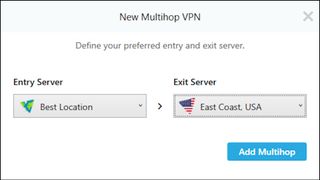
Advanced features include MultiHop VPN, allowing you to connect to one location and exit from another. This makes it even more difficult for anyone to trace back and identify you.
Hide.me claims to support P2P on most servers. We verified this by connecting to five different locations and had hassle-free torrenting in each case.
Furthermore, unlike some of the competition, Hide.me doesn't just make vague promises about its unblocking abilities. Its Unblock page lists the many sites it supports, including Netflix, BBC iPlayer, Hulu, Amazon Prime, Disney Plus, ShowTime, and more.
Recent improvements have been more about enhancing the service than delivering huge changes. But they're worthwhile enhancements, in particular the ongoing upgrade of servers from 1Gbps to 10Gbps. Plenty of providers claim to be doing the same but are shy about telling you how many locations they've upgraded. Hide.me is much more transparent and highlight 10Gbps servers in the apps.
Hide.me pricing
Hide.me's monthly plan is fairly priced at $9.95. Most providers charge somewhere in the $10-$13 range, although a few are significantly cheaper (Mullvad asks around $6).
The annual plan is available for an above-average $5.82 a month. Hide.me used to throw in 2TB of Internxt cloud storage, but no more. Now, it's the VPN only. Most providers are a little cheaper at around $4-5 for annual subscriptions, and a few cost even less (you'll pay a monthly $3.33 for Private Internet Access, $2.08 for FastestVPN).
The two-year plan offers the best value at $3.45, but even here, there's money to be saved elsewhere. Atlas VPN's three-year plan costs $2.08 a month, for instance. Looking at the totals, paying $89.95 to Hide.me gets you coverage for two years with two months free – but three years of protection (with three months free) at Atlas VPN costs $71.52.

Whichever duration you choose, there is a wide range of payment options to purchase it. This includes cards, Bitcoin, PayPal, Google Pay, Amazon Pay, and perhaps other providers (the precise list depends on your location.)
If you hand over your cash and regret it later, no problem! You're protected by a no-questions-asked 30-day money-back guarantee. As long as you’ve never had a refund from Hide.me previously.
If you decide that you don’t want to pay anything, the free plan now supports eight countries (Canada, France, Germany, Netherlands, Singapore, Spain, United Kingdom, United States). The restrictions include no streaming support, port forwarding, or multihop VPN.
The good news is there's P2P support everywhere, and absolutely no annoying data limits. You can use the service as much as you like.
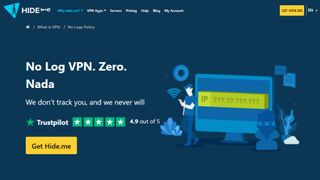
Privacy
Hide.me has a strict no logging policy. The company claims, "We do NOT keep logs of your VPN sessions, browsing behavior, websites you visit, or any activity related to your VPN connection. In addition, we NEVER store VPN connection logs and timestamps that match your incoming and outgoing IP address or session duration."
Hide.me does briefly record your randomly generated username and internally assigned (non-public) IP address when you connect, but this is only for troubleshooting purposes, and the company says even this troubleshooting log is securely wiped every few hours.
Hide.me says it will comply with court orders received by recognized legal authorities with jurisdiction over them. But again, that's to be expected, and if the logs don't show anything significant, that won't matter at all.
The company claims this is supported by a comprehensive audit, and that 'Hide.me has been certified as the most anonymous VPN service in the industry.'
It turns out that the audit dates from 2015, though. There's little information on the scope of the audit and no report you can read. Hide.me deserves real credit for realizing the importance of audits so long ago – some providers still don't get it, even today – but we think it's probably time to take another, something more thorough and transparent, where everyone can read the full results.
In the meantime, there's a simple metric we use to get a feel for how any provider is handling your privacy, and that’s how many trackers and third-party cookies are used on its website. The Blacklight privacy inspector gave us the answer; none at all. That's not unique - Mullvad, Proton VPN, Windscribe, and a handful of others are also tracker-free - but it's unusual, and suggests Hide.me is making a real effort to maintain your privacy.
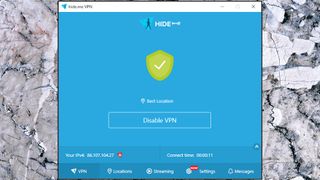
Apps
Hide.me's Windows app has a clear and straightforward interface. A large Enable button plugs you into the nearest server, the full location list (countries, expandable to cities in some cases) is just a click away, and a navigation bar has buttons for the streaming service, app settings, and more.
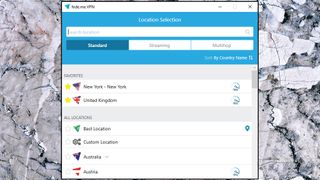
The flexible location list can sort your options by name, or use ping time to show the fastest servers at the top. Begin typing a city or country name in the Search box and the list updates to display any matches (typing MIA cuts the list to just Miami, for instance.) A Favorites system enables grouping your most-used servers together for speedier access later.
A Streaming tab connects you to the best locations to unblock streaming platforms in a lengthy list of countries: Argentina, Australia, Austria, Brazil, Canada, Croatia, France, Germany, Italy, Japan, Norway, Poland, Portugal, Spain, Switzerland, Turkey, United Kingdom, and United States. That's nine countries added since our last review. Impressive!
Connection times were good in most cases, with WireGuard getting us online in 1-2 seconds. The app doesn't appear to have a connection timeout, though, and a couple of times we found it hung on its 'Initializing service connection...' animation for minutes.
Digging into the details, it looked like Hide.me's Windows service had failed, and the app wasn't able to restart it. That can happen, but the top providers do a better job of handling it. ExpressVPN's Windows app recognizes a service failure immediately, for instance, without leaving you waiting for minutes. Then, it either fixes the problem all on its own or tells you what to do next.
Typically, though, connections ran smoothly, with the app making good use of notifications to keep you informed about what it's doing. Switch back to your other apps, and Hide.me will let you know when you’re protected, and when you’re not.
Hide.me's MultiHop feature gives you another option, good news when you need the best possible privacy. Choose an entry server of New York, say, and that's where you'll connect, but you'll be redirected through Hide.me's network to your pick of exit servers. Websites will think you're in the UK, and even if an attacker manages to compromise the London server, they won't be able to link the activity to your account as you've accessed it using the New York server, not your own IP.
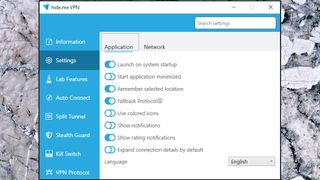
Settings
There's real depth here. The app supports no less than five protocols (WireGuard, OpenVPN, IKEv2, SoftEther, SSTP), for instance, with a stack of configuration options including IKEv2 stealth mode, custom and random ports, tunnel via IPv4 or IPv6, and the option to enable Bolt (Hide.me's custom speedup technology). More on that, later.
That's just the start. While most VPN apps ignore IPv6 entirely, or at best give you an option to disable it, Hide.me offers complete support and control. You can have the app connect via IPv4 only, IPv6 only, prefer IPv4 but use IPv6 as a fallback, or prefer IPv6 but use IPv4 as a fallback. That'll probably get you better speeds if you can use IPv6 and Hide.me's ability to handle both protocols reduces the chance of data leaks.
The advanced features continue everywhere you look. For example, split tunneling support enables defining which apps use the VPN, and which will use your regular connection. Plus, the client doesn't just have a single on/off kill switch setting to define what happens if the connection drops. It can run customs scripts, too. You get it to close apps, run others, whatever you like. You can also define whether scripts are run as the current user or an administrator.
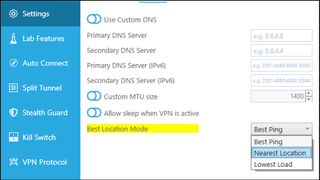
There's a lot to explore, and sometimes we couldn't remember where to find a particular setting. Fortunately, the app has a settings Search box. If you know you want to customize the Best Location feature, just type 'best' in the Search box, click the link, and the app will take you to the right page, and even highlight the option for you. A neat touch we've not seen with anyone else.
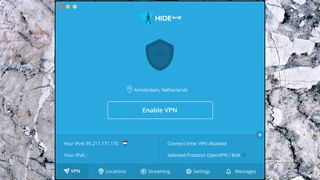
Mac app
Hide.me's Mac app is a near clone of the Windows edition, with only the odd tiny visual detail and occasional caption changes to tell them apart.
Connection times were much faster than we saw on Windows, and we didn't have any connection failures. Real-world use was otherwise much the same. The app was easy to use, there were no unexpected drops, and everything worked more or less as we'd expect.
There's a decent set of advanced options, too. WireGuard, OpenVPN, and IKEv2 protocol support, a kill switch, auto-connect when you access untrusted networks, and split tunneling. If any of this technology doesn't quite deliver, you can even raise a ticket from within the app.
There are a lot of advanced Windows features which haven't made it to the Mac. There's no VPN-wide custom DNS option, no custom MTU, no way to tweak how Best Location is chosen, no IPv6 tunnel option, no IKEv2 configuration tweaks, and no real kill switch configurability beyond on or off.
If you're not interested in VPN technicalities then none of that is likely to matter very much, and this is still a quality Mac app. It's not difficult to use, performance is good, and it has far more features than most.
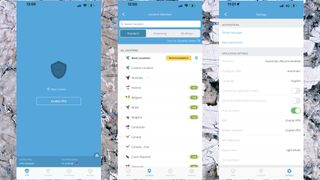
iOS app
Most VPNs focus their development time on desktop apps, and iOS users in particular are expected to be grateful with whatever scraps are left. Fortunately, no one told Hide.me that this is the way things are supposed to be. Its own iOS offering is surprisingly powerful.
This isn't visible initially, because the app has the same simple and appealing interface as the rest of the range. It has the blue and white color scheme, big connect button, and not a whole lot else. Don’t let that fool you, we tapped a few buttons and quickly got a feel for just what the app can do.
The Location picker has all the features we saw on the desktop including the Favorites, the Streaming and Multihop lists, the search box, sorting, and more. You probably won't need all of that, but just the ability to bring favorite servers to the top of the list can make your VPN life so much easier.
IOS apps typically have almost no settings, but this one outperforms some of the Windows competition. There's support for IKEv2, OpenVPN UDP, OpenVPN TCP and WireGuard, for instance. The app can automatically connect when you use Wi-Fi or mobile networks. There's a kill switch. You can choose a custom DNS server. You even get to control whether the tunnel uses IPv4 or IPv6, assuming you've a reason to care and if you don't, no problem, the app has sensibly chosen defaults.
The feature list is still a little shorter than the desktop apps (no split tunneling, for instance), but that's inevitable, iOS just doesn't allow anything like the same level of system control. Despite that, this is a top-notch iOS app. It's easy to use and way more configurable than most of the competition.
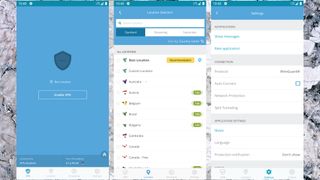
Android app
Hide.me's Android app didn’t spoil the excellent record for cross-platform consistency. Hide.me has paid real attention to detail with app design, and essentially the Android edition has the same appealing interface and capable location list as the rest of the family.
A better-than-most feature list includes WireGuard, OpenVPN, and IKEv2 support, auto-connect for unsecured networks, and a custom DNS option.
The Android app beats iOS with split tunneling, where you're able to define which apps use the VPN tunnel, and which don't. But it does lack some functionality. For example, it doesn't allow you to decide whether to use IPv4 or IPv6.
Overall, this is an impressive mix of power and ease of use. You don't have to register to use Hide.me's free plan, or hand over any personal details – just install it from your app store, explore the various screens, and see how it works.
And if you don't understand something, or there's some other problem? You can even raise a ticket from within the app. Now that's what we call convenient.

Kill switch
We checked out the Windows app kill switch by manually closing WireGuard, OpenVPN and IKEv2 connections and everything worked as it should – our internet access was blocked right away, a notification warned us about the problem, and the app reconnected within seconds.
The kill switch didn’t always work when we switched locations, though. The app appears to close the first connection, then try to connect to the new server, and our device was sometimes able to use its regular internet connection until the tunnel was re-established.
This is unlikely to be a big issue for most users. If you’ve decided to switch locations, that’s a very strong indication that you’ve finished your torrenting, your online banking or whatever else you’re trying to protect, and a few seconds of unprotected internet access may not matter at all.
It is still a weakness, though, and one that could be a concern in the most privacy-critical situations.

Privacy tests
Hide.me's Windows apps boast plenty of protocols, but are they set up for maximum security? We can't see every detail of what's going on, but checking app configuration files and logs provides some useful information.
The results were broadly positive, with OpenVPN using AES-256-CBC encryption and SHA256 authentication. IKEv2 connections provided the same reliable AES-256 shield, while SoftEther appeared to use its standard (and very acceptable) default settings.
The app's WireGuard and OpenVPN files were more than a year old, which means they're missing plenty of patches and bug fixes. This is unlikely to have any real practical impact on your privacy, but we'd like to see Hide.me update these more often, just to keep any risks to a minimum.
We spotted a slightly dubious design decision with the app's OpenVPN connections, as it saved our username and password to disk in plain text. This also isn't that big a deal (if you've got malware reading files, Hide.me's logins are the least of your worries), but it's unnecessary, and most apps do a better job of concealing your credentials.
Once we got connected, Hide.me excelled on the privacy front, with IPleak.net, DNSleak.com, and DNSleaktest.com confirming that it correctly shielded our IP, allocated us a new address from our chosen country, and blocked DNS leaks at all times.
Virtual locations
Most VPNs have very long location lists, but their servers aren't always where you expect. If they're in a country that maybe has poor internet connectivity, then a provider will often host them elsewhere.
This can often be a good idea. If a VPN offers a Monaco location, and allocates you a Monaco IP address when you connect, but the servers are really in a super-fast French data center just a few miles away, should you care very much? We'd say no.
But what if you're in Cambodia, and you connect to a Cambodia location, but the server is really located in New York? That's likely to deliver a big and very unexpected performance hit.
We tested ten Hide.me locations to get a feel for what the company is doing.
In most cases, Hide.me's servers turned out to be in the advertised locations and some appeared to be virtual locations but weren't far away. Still, we found a couple of notable exceptions. Hide.me's Mexico location appears to be hosted on the US east coast, and its Morocco servers are closer to Quebec or Ontario.
This may not be an issue for everyone. The servers correctly give you Mexican and Moroccan IP addresses, so they’ll work just as you expect, and if you're in North America, having servers closer by might improve performance.
Providers should be transparent about their use of virtual locations, though, in order that potential customers can make up their own minds. Hide.me doesn’t highlight which locations are virtual, or tell users where they really are (which ExpressVPN does), and we'd like to see that change.
Netflix and streaming
Most VPNs claim they can help you access geoblocked websites, and Hide.me is no exception, with the company promising that you'll 'avoid annoying censorship.'
And this turned out to be correct, as Hide.me got us access to Netflix in the US, UK, Australia, Canada and Japan.
It scored with our other test US platforms, too, working with both Amazon Prime Video and Disney Plus.
The good news kept coming, too. Not only did Hide.me unblock BBC iPlayer, ITV and Channel 4 in the UK, but it delivered with Australia’s 9Now and 10 play, too.
That’s a perfect 100% unblocking score, a great result. Hide.me did just as well in our last review, too, which suggests the company didn’t just get lucky – it’s working hard to unblock everything possible, and then make sure those services stay available long-term.
(If you plan on testing Hide.me for yourself, keep in mind that you only get this level of success from the paid product – the free plan doesn't support unblocking streaming sites.)

Performance
We assess VPN speeds by running multiple automated speed tests using several platforms including SpeedTest's website and command line app, Measurement Lab, and Cloudflare.
Hide.me’s data center results were pleasantly unexpected. WireGuard speeds reached a decent mid-range of 580Mbps and switching to regular OpenVPN got us an above average 260Mbps. Using OpenVPN with Hide.me's Bolt got us an amazing 950Mbps.
That's a huge achievement, but there's an important point to keep in mind. Bolt is only available in the Windows app. If you're using Bolt on any other platform, performance is going to be more ordinary, though still very acceptable for most purposes. Would you really be upset if your VPN 'only' managed 580Mbps? Didn't think so.
Hide.me review: Final verdict
Hide.me is a speedy and highly configurable service, which unblocks almost everything and has an array of unusual and advanced features – in short, one of the best VPNs around for more experienced and demanding users. If you're looking for power then go check out the free version right now, see what it can do for you.

Mike is a lead security reviewer at Future, where he stress-tests VPNs, antivirus and more to find out which services are sure to keep you safe, and which are best avoided. Mike began his career as a lead software developer in the engineering world, where his creations were used by big-name companies from Rolls Royce to British Nuclear Fuels and British Aerospace. The early PC viruses caught Mike's attention, and he developed an interest in analyzing malware, and learning the low-level technical details of how Windows and network security work under the hood.

Hey listen! The live-action Legend of Zelda movie just got a 2027 release date confirmed by Sony and Nintendo

New Windows 11 roadmap will tell you exactly when to expect Microsoft’s next annoying feature
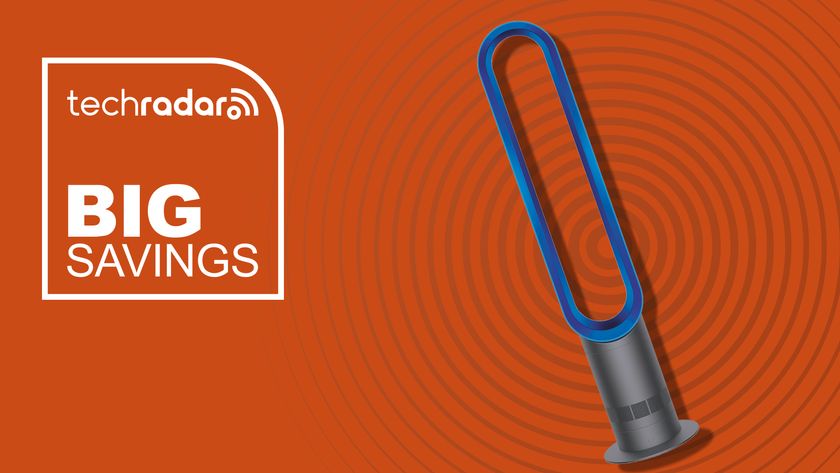
Get ready for summer with massive discounts on Dyson fans at Amazon – here are today's 3 best deals
